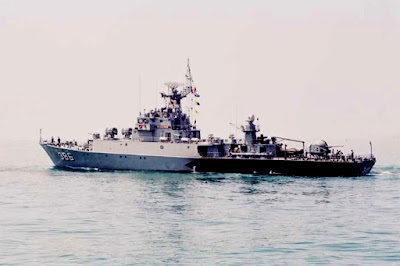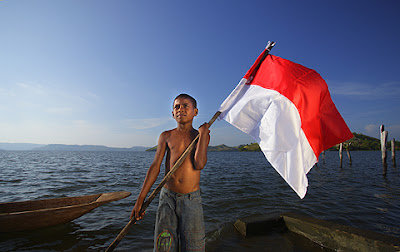Sukarno, the first president of the Republic of Indonesia, ever gave us a message : "Do not ever forget history." Benny Wenda and Wim Rocky Medlama (one of KNPB leaders) ever made a statement that no West Papuan fought for Indonesian independence. Those people are blind about history. The Indonesian government has listed total 159 national heroes until today. Four of them are West Papuans. Here are our national heroes from West Papua :
Silas Ayari Donrai Papare
Silas Papare was born in Serui, Yapen Islands, on 18 December 1918. He was graduated from medical school in 1935. He was imprisoned by the Dutch because of provoking Papuan Batallion to rebel against the colonial government. In Hollandia (now Jayapura) prison, he met Gerungan Saul Samuel Jacob Ratulangi, well-known as Sam Ratulangi (future governor of Sulawesi), who also imprisoned for his resistance against the Dutch. From this point, he knew that West Papua should be part of Indonesia in the future.
On 17 August 1945 following the surrender of Japan, Sukarno declared the independence of Indonesia. Along with Thung Tjing Ek (a Chinese descendant living in West Papua), Silas Papare established PKII (Partai Kemerdekaan Indonesia Irian or Irian Indonesian Independence Party). He and other Papuans were captured after raising Red and White flag in year 1947. But he successfully escaped from the prison and fled to Yogyakarta. In 1949, he established Badan Perjuangan Irian or Irian Struggle Corps in Yogyakarta with purpose to drive out the Dutch and integrate West Papua to Republic of Indonesia.
The relation between Indonesia and the Netherlands was getting worse. Many countries supported Indonesia to retake West Papua from the Netherlands. Indonesia gained support in Colombo Conference and Asia-Africa Conference as part of anti colonialism campaign. The US under John Fitzgerald Kennedy also suppressed the Netherlands to hand off West Papua. Dutch products boycott had spread across Indonesia. Indonesia and the Netherlands were on the eve of total war. On 19 December 1961, Sukarno announced military campaign to liberate West Papua.
To stop the conflict, Indonesia and the Netherlands met in New York under US mediation. The Dutch had cheated Indonesia by making false independence of West Papua on 1 December 1961. It was Dutch maneuver to prevent West Papua be united with Indonesia. Silas Papare was sent by the Indonesian government to represent Indonesia in New York. This meeting results New York Agreement.
According to New York Agreement, West Papua would be under UNTEA (United Nations Temporary Executive Authority) before given back to Indonesia. On 1 May 1963, West Papua was officially integrated to the Republic of Indonesia. Silas Papare died on 7 March 1973. He was recognized as national hero on 14 September 1993. His famous words are "Do not praise me but continue my struggle." To honor Silas Papare, a meeting hall in Serui is named after him. A Parchim class corvett is also named as KRI (Kapal Republik Indonesia or Republic of Indonesia Ship) Silas Papare to honor him.
KRI Silas Papare
Frans Kaisiepo
Frans Kaisiepo was born in Biak on 10 October 1921. He studied at Papua bestuurschool (police school of Papua) in Hollandia in 1945. The idea of independent Indonesia had spread among the students. Frans Kaisiepo proposed the name of the most eastern island in Indonesia from "New Guinea" change to "Irian" which from Biak language means "hot land". From the word "Irian", he made acronym "Ikut Republik Indonesia Anti Nederland" or "Join Anti Netherlands Republic of Indonesia". He also asked his brother, Markus Kaisiepo, to change Papua bestuurschool to Irian bestuurschool.
On 31 August 1945, Frans Kaisiepo, Markus Kaisiepo, Corinus
Krey, and the other Komite Indonesia
Merdeka (Free Indonesia Committee) members hoisted Red and White flag and sang
Indonesia Raya, Indonesia's national anthem. Frans Kaisiepo was also one of the founders of Partai Indonesia Merdeka (Free Indonesia Party) led by Lukas Rumkorem. Following the capture of Silas
Papare, Frans Kaisiepo and Johan Ariks continued the struggle to liberate West
Irian from Dutch control. On March 1948, a rebellion broke in Biak. Frans
Kaisiepo was one of the brains.
The Netherlands and Indonesian met in Round Table Conference on 27 December 1949 in Den Haag. The Indonesian War of Independence was over. To get Frans Kaisiepo's sympathy, the government of the Netherlands asked him to be Dutch delegation during Round Table Conference. But he directly refused the offer. He also protested the Netherlands for separating West New Guinea from Indonesia in Round Table Conference.
The years after Round Table Conference, confrontation between Indonesia and the Netherlands over West Papua got international attention. To save her face in international community, the Netherlands quickly prepared independence for West Papua. It was no more than making West Papua as a puppet state. On 19 December 1961 in Yogyakarta, Sukarno announced military campaign to liberate West Irian. This campaign is known as Trikora Operation. Frans Kaisiepo actively helped Indonesian troops landing in West New Guinea during Trikora Operation.
After the official integration of West Papua, West Papua became the 26th province of Indonesia with name West Irian (now it is divided into West Papua province and Papua province). Frans Kaisiepo was appointed to be the second governor of West Irian succeding Elias Jan Bonay. Frans Kaisiepo died on 10 April 1979. He was recognized as national hero on 14 September 1993. To honor his service for the country, an airport in Biak is named after him.
Frans Kaisiepo Airport
Marthen Indey
Marthen Indey was born in Doromena, Hollandia, on 14 March 1912. He was a policeman and worked for colonial government. He was ordered by the Dutch colonial government to watch the independence activists who was exiled by the colonial government. His nationalism grew after met those independence activists. Along with 30 men, he planned to kidnap the Dutch officers. But their plan was detected and Marthen Indey was moved to isolated area in Digul.
When Japanese occupied Dutch East Indies during World War II, he followed the Dutch East Indies government in exile to Australia. In 1944, the Allied troops under Douglas McArthur invaded the Japanese-held New Guinea. Following the arrival of Allied forces in West New Guinea, Marthen Indey went back to his homeland. He asked by the Allies to train the locals to fight the Japanese. In the following year, he became the district chief of Arso Yamai and Waris for two years.
In these years, he still tried to communicate secretly with the independence activists whom he ever met before. On January 1946, he also communicated with pro Indonesia Moluccans in Ambon. On October 1946 along with Frans Kaisiepo and the others, Marthen Indey joined Partai Indonesia Merdeka. He and twelve tribal chiefs sent protest to the Dutch government over its plan to separate West Papua from Indonesia. Because of his action, the Dutch jailed him for three years.
In these years, he still tried to communicate secretly with the independence activists whom he ever met before. On January 1946, he also communicated with pro Indonesia Moluccans in Ambon. On October 1946 along with Frans Kaisiepo and the others, Marthen Indey joined Partai Indonesia Merdeka. He and twelve tribal chiefs sent protest to the Dutch government over its plan to separate West Papua from Indonesia. Because of his action, the Dutch jailed him for three years.
During Trikora Operation, Marthen Indey saved many Indonesian troops who were sent to infiltrate the Dutch-held New Guinea. Many of them were hid in his house to avoid Dutch patrol. Indonesia had sent more than a hundred warships and landed 16,000 troops to liberate West Papua during Trikora Operation. In 1962, he released Kota Baru Charter which stated West Papuans willing to be part of Indonesia. To stop the conflict, Indonesia and the Netherlands met in New York and Marthen Indey was one of Indonesian delegations who were sent to New York.
After West Papua officially integrated to the Republic of Indonesia on 1 May 1963, Marthen Indey became MPRS (Majelis Permusyawaratan Rakyat Sementara or Temporary People's Consultative Council) member for period 1963 until 1968. Marthen Indey died on 17 July 1986. Along with Silas Papare and Frans Kaisiepo, he was recognized as national hero on 14 September 1993 by President Soeharto. A hospital in Jayapura is named Marthen Indey to honor the national hero.
Johannes Abraham Dimara
Johannes Dimara was born in Biak on 16 April 1916. He was son of William Dimara, a korano or village chief. The son of korano was used to be called Arabei. Arabei means "lizard" in Biak language. When he was 13, he was adopted by an Ambonese named Elisa Mahubesi. He finished his primary school in 1930 and continued studying agriculture until 1935. He studied again at Christian school and then worked as Christian religion teacher.
During Indonesian War of Independence, Johannes Dimara was a harbor policeman in Namlea Port, Buru Island. His nationalism grew after he met some Moluccan sailors from ALRI (Angkatan Laut Republik Indonesia or Republic of Indonesia Navy). They arrived with a ship named Sindoro commanded by Captain Ibrahim Saleh and Yos Sudarso (later he died in Battle of Arafura Sea). These sailors came to spread Indonesian proclamation of independence in Moluccas.
In 1950, situation in Moluccas was getting worse because of rejection of NIT (Negara Indonesia Timur or State of East Indonesia, a puppet state created by the Dutch to divide Indonesia) by pro Dutch Moluccans especially by ex-KNIL (Koninklijk Nederlands Indisch Leger or Royal Netherlands Indies Army) soldiers. RMS (Republik Maluku Selatan or Republic of South Moluccas) was proclaimed by Christiaan Robbert Steven Soumokil, a pro Dutch Moluccan, to separate Moluccas from Indonesia. Johannes Dimara helped the Indonesian government fought RMS rebels.
Johannes Dimara established OPI (Organisasi Pembebasan Irian or Irian Liberation Organization) on October 1954. He and 40 men infiltrated the Dutch. The clash between OPI and Dutch troops was inevitable. Eleven of his men died and the rest was arrested and jailed in Digul. After he was freed, he back again fought the Dutch by establishing Gerakan Rakyat Irian Barat (West Irian People's Movement). In 1961, Sukarno appointed him to be Indonesian delegation for UN to discuss West Papua problem.
On 17 August 1962 during the rally in front of presidential palace, Johannes Dimara wore broken chains as symbol that West Papua had been liberated. This action inspired Sukarno to build West Irian Liberation Statue. He died in Jakarta on 20 October 2000. Along with Johannes Leimena, a hero from Moluccas, he was recognized as national hero on 11 November 2010. His biography was written in book Fa Ido Ma, Ma Ido Fa : Lintas Perjuangan Putra Papua by Carmelia Sukmawati. Johannes Dimara was well-known as a simple and humble man.
Fa Ido Ma, Ma Ido Fa : Lintas Perjuangan Putra Papua by Carmelia Sukmawati
There are still many West Papuans waiting to be recognized as national hero. They are Lukas Rumkorem, Petrus Watebossy, George Henk Ayerbaba, Lodewijk Mandatjan, Petero Jandi, etc. Some of them are still alive. They are Ramses Ohee and Frits Kirihio. It is our duty as West Papuan young generation to keep Red and White flag raising over West Papua until our last breath.
This is our turn to keep this flag raising over our beloved West Papua






















